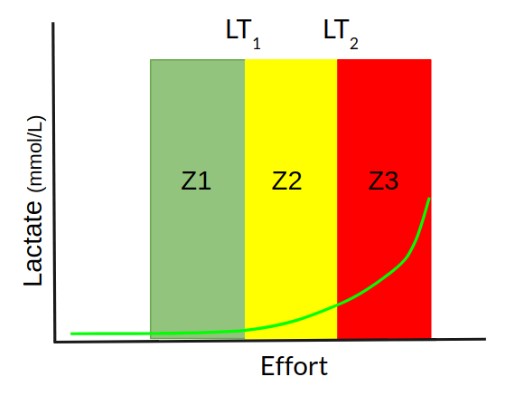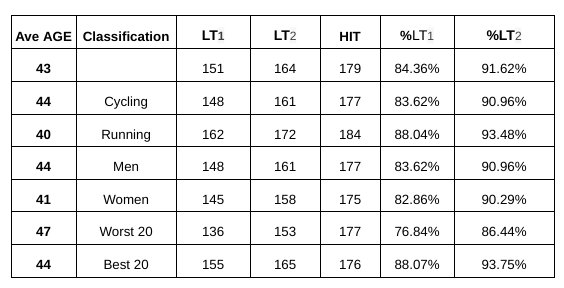
You could go out and exercise, getting the miles in and no doubt you would improve. However different energy systems and types of events respond to more specific training. Just covering a lot of distance at a reasonably high tempo may even be negative, so called “junk miles” leading to over-training. Junk miles are hard enough to leave you tired but not sufficiently hard to bring about the necessary physiological adaptations.
To target training a three zone heart rate based system derived from lactate thresholds can be used. This is simpler than the more specific 5, 6 and sometimes 7 zone models used by cyclists training with power meters but is sufficient for endurance training and the simplicity makes following training programs easier. It should be remembered that Heart Rate is a lagging indicator. Think of it like the temperature gauge on a car engine. It will take some time to warm up, or even overheat. Therefore it is not good for tracking very short efforts.
Lactic acid is a by-product of burning glucose in the muscles. It is measured in millimoles per liter of blood (mmol/L). As you start to exercise the amount of lactic acid starts to increase very slightly. The point where the increase starts to be measurable is called the first lactate threshold or LT1. This occurs at concentrations of around 2 mmol but it depends on individuals; for highly trained athletes it may be closer to 1 mmol. The amount of lactic acid will now start to increase more rapidly, the point where the body can’t clear it out of the system is called the second lactate threshold or LT2 at 4 mmol (this is a similar level to Functional Threshold Power or FTP); again for trained athletes this figure will be lower, meaning they tire less quickly. The quantity will now increase exponentially until you can’t exercise further.

The key to endurance events is basic speed. To improve this you actually need to train slowly, below the LT1 level. This is the effort you can maintain for a long period, from a couple of hours a whole day and is fuelled in part by fat reserves. Sub LT1 training will improve fat oxidation and is an important factor in the speed you can develop over extended periods.
Lactate thresholds are determined by taking blood samples using devices that can cost up to a thousand dollars. Beyond the reach of most amateur sportsmen. However we can estimate LT1 and LT2 heart rates from our maximum heart rate, at least accurately enough for training.

[Dr. Karel Pardaens]1 tested 173 subjects in order to measure heart rates at LT1 and LT2 levels. The first observation is that the maximum heart rate (HRmax) doesn’t vary greatly between untrained to trained subjects and is more related to age. So LT1 and LT2 are best derived from this value. LT1, and to a lesser extent LT2 heart rates respond well to training, there was a 19 bpm gap between trained and untrained subjects, this dropped to 12 bpm at LT2. Improving LT1 and LT2 points means you can ski faster and further before lactates start to build up in the bloodstream. The difference between men and women was not marked and the women were less well trained but there was around a 10bpm difference between running (and by extension cross country skiing) and cycling. HRmax refers to your absolute maximum heart rate, HRpeak refers to your maximum heart rate in a particular exercise.
Pardaens noted that the difference in LT1 HR for untrained and trained subjects was 88 to 77% of HRmax. He suggests using a limit of 80% of HRmax for this figure as 88% will be too strenuous for trained subjects and 77% too easy for the unfit who need a bit of a boost at the start of training.
1). https://www.backtobasicsinsports.com/en/blogitem/111 "Pardaens, Karel: In search of an upper limit for basic endurance training"
⬅ Energy Systems | Calculating Lactate Thresholds ➡ | ⬆ Contents